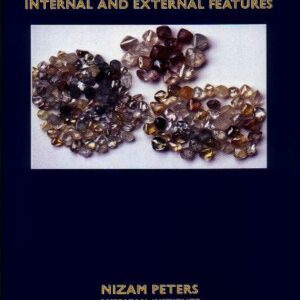Description
EXTERNAL FEATURES
External features can be divided into four general groups in which they occur in many different varieties and form.
1. Features that are primarily natural in origin (Chapters one thru four)
2. Features resulting from the manufacturing process (Chapter five and six)
3. Features resulting from wear and tear (Chapter seven)
4. Features that are both external and internal (Chapter eight)
CHAPTER ONE
Naturals,growth markings and radiation stains.
CHAPTER TWO
External grainings, twinning lines and knots.
CHAPTER THREE
Cavity, pits and nicks.
CHAPTER FOUR
Surface hairline feathers, cleavage and fracture breaks close to the surface.
CHAPTER FIVE
Scratches, wheel marks, cutting lines (polishing lines) and extra facets.
CHAPTER SIX
Bearded girdle, rough girdle and abrasions.
CHAPTER SEVEN
Burnt facets, burn marks, slight percussion marks or bruises.
CHAPTER EIGHT
Cleavage and fracture breaks on the surface.
INTERNAL FEATURES
Internal features can occur in many different varieties and shapes. They can be classified into four general categories.
1. Features resulting from mineral type inclusions (crystalline and solid) imbedded in the body of the diamond (Chapter nine)
2. Features resulting from impurities that existed within and around the formation of the crystal (Chapter 10)
3. Features resulting from structural defects during and after the process of crystallization (Chapter eleven and twelve)
4. Features resulting from the manufacturing process and excessive wear and tear (Chapter thirteen)
CHAPTER NINE
Included crystals, internal knots, twinning lines, internal graining and swirl lines.
CHAPTER TEN
Carbon inclusions, pinpoints inclusions, carbon pinpoints and clouds.
CHAPTER ELEVEN
Fracture and cleavage feathers, internal hairline feathers and colored feather inclusions.
CHAPTER TWELVE
Color banding, color zoning, stress and strain.
CHAPTER THIRTEEN
Bearded girdle (feathered girdle), rough girdle, excessive percussion marks or bruises.
CHAPTER FOURTEEN
Internal inclusions – from rough crystal to polished diamond.
5.15ct. Rough Diamond
4.72ct. Rough Diamond
7.61ct. Rough Diamond
17.58ct. Rough Diamond
5.32ct. Rough Diamond
CHAPTER FIFTEEN
1. The diamond manufacturing process and its relation to inclusions.
2. Planning the rough in relation to shape and inclusions.
3. Sawing the rough with consideration to inclusions.
4. Bruting the rough in relation to inclusions.
5. Cutting and polishing the rough with regard to inclusions.





